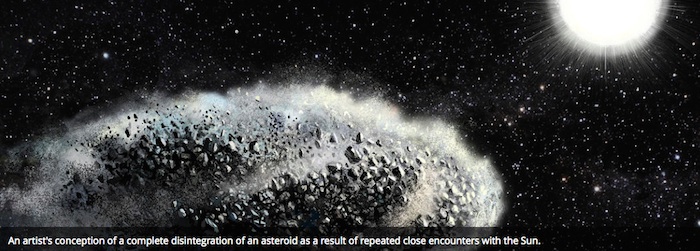.

Puzzling asteroid and meteor observations can now be explained.
For two decades it was thought that most near-Earth objects (NEOs) end their existence in a dramatic final plunge into the Sun. A new study published in the journal Nature finds instead that most of those objects are destroyed much farther from the Sun than previously thought.
This surprising new discovery explains several puzzling asteroid and meteor observations that have been reported in recent years.
- Initially our aim was to construct a state-of-the-art model of the NEO population that is needed for planning future asteroid surveys and spacecraft missions, says planetary scientist Mikael Granvik, currently at the University of Helsinki.
THE BEST-EVER MODEL
The model that describes the NEOs’ orbit and size distributions was completed as planned, but the research also led to an important advance in asteroid research.
- We modelled different observational selection effects, and combined them with observational data and NEOs’ well-understood, statistical orbit distributions that vary depending on an NEO’s specific source region in the main asteroid belt.
But the team noticed that their model had a problem: the number of NEOs detected was 5 per cent less than the model predicted. They then spent a year verifying their calculations before they came to the conclusion that the problem was not in their analysis but in their assumptions of how the Solar System works.
The model was then modified to the new hypothesis that NEOs are destroyed if they spend too much time within about 10 solar diameters of the Sun, and this lead to an excellent agreement between the model and the observed population of NEOs.
WHY SOME METEOR STREAMS LACK PARENT OBJECTS
The team’s discovery helps to explain several other discrepancies between observations and predictions of the distribution of small objects in our Solar System.
- Astronomers have been unable to match most of the meteor streams on orbits closely approaching the Sun with known parent objects, says Granvik.
He and his research team now suggest that the parent objects were completely destroyed when they came too close to the Sun.
The team can now also explain why NEOs that approach closer to the Sun are brighter than those that keep their distance from the Sun.
DARKER ASTEROIDS ARE MORE EASILY DESTROYED
- Darker asteroids that have been orbiting closer to the Sun have already been destroyed. The fact that dark objects are more easily destroyed implies that dark and bright asteroids have a different internal composition and, possibly, structure.
According to Granvik, their discovery of the catastrophic loss of asteroids before a collision with the Sun allows planetary scientists to understand a variety of recent observations from a new perspective.
- Perhaps the most intriguing outcome of this study is that it shows that it shows that one must account for the asteroids’ physical properties when constructing population models.
- In simple terms one can say that it is now possible to test models of asteroid interiors simply by keeping track of their orbits and sizes.
This research led by Mikael Granvik is published in Nature, 18 February.
Quelle: University of Helsinki
4608 Views
